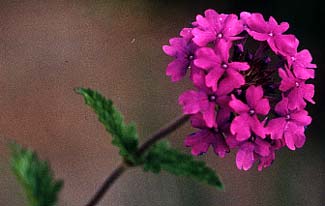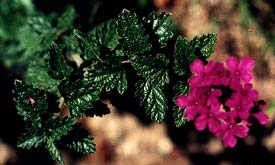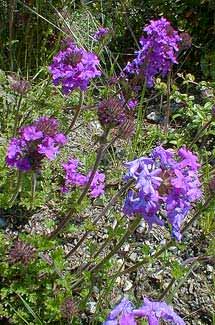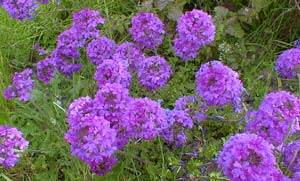
'Homestead Purple'
Trailing Verbena, aka
"Beauty's a flower,
an' the days o' life are long,
There's little knowin'
who may live to sing another song."
-Moira O'Neill
(1870-1920)
(1870-1920)
Verbena canadensis 'Homestead Purple' has tough leaves resembling Brazilian Verbena, except it is not tall & upright. It is a twisty trailing clumper about a foot tall & can spread to three feet wide or wider. It is potentially rampant.
Because it can be an aggressive plant it shouldn't be placed with small perennials which it will out-compete. Ours is with tall Brazilian verbena as it adds a layer of blooms along the ground while the Brazilian verbena & an equally tall clump of Red Valerian, light up the garden at eye-level. It also shares its immediate vicinity with Red Barberries bushes & other such low-maintenance plants & shrubs suited to this roadside garden.
 Homestead Purple is an heirloom hybrid that seems to have hybridized by chance in an old Atlanta Georgia garden. It is a cross between Verbena canadensis which is native of the American southeast ranging as far north as Iowa, pollinated by an unknown Verbena that had not survived in the Atlanta garden by the time a trained eye recognized the "otherness" of what was either a chance hybrid or long lost & forgotten cultivar.
Homestead Purple is an heirloom hybrid that seems to have hybridized by chance in an old Atlanta Georgia garden. It is a cross between Verbena canadensis which is native of the American southeast ranging as far north as Iowa, pollinated by an unknown Verbena that had not survived in the Atlanta garden by the time a trained eye recognized the "otherness" of what was either a chance hybrid or long lost & forgotten cultivar.The story of its rediscovery has become almost legendary. Alan Armitage is an authority on perennials, & Mike Dirr is an authority on woody shrubs. These two University of Georgia horticultural professors were driving back from a trip to Athens, Georgia, when they did a sudden U-turn to see what the heck was that amazingly colorful flower in an old homestead garden.
 They knocked on the door but the woman who lived there only knew she had always had it in her garden. She shared starts with professors Dirr & Armitage, & from those a new popular verbena was introduced to the world.
They knocked on the door but the woman who lived there only knew she had always had it in her garden. She shared starts with professors Dirr & Armitage, & from those a new popular verbena was introduced to the world.The fragrant bright purple flowers are considerably larger than most Verbena, & are upon this perennial from May through all of summer right up to Autumn's first frost or later. In warmer climates than ours blooms can start as early as March.
In 2002 ours seemingly stopped blooming in August then partway through September had another flourish of blossoms, then retained its ruffly deep green leaves unharmed through winter, beginning its long bloom cycle anew in May. In the south it will be reliably evergreen all year brown, but can sometimes partially die back in the Northwest, though ours happily has had little or no die-back.
A smidgen of slow-release fertilizer in the spring is plenty. It does not ordinarily require any pruning, though deadheading definitely extends bloom time, & if it begins to sprawl into too much of a groundcover, it can be hard-pruned in Autumn & will return in a more compact manner the following spring.
 'Homestead Purple' is regarded the most winter hardy of the trailing verbenas, & has been used in breeding programs to increase hardiness in other trailing varieties. Indeed, the extreme popularity of 'Homestead Purple' has caused a veritable explosion of V. canadensis hybrids that will succeed in temperate areas where trailing verbenas were formerly grown if at all as defacto annuals. Hardy varieties include 'Rosea,' 'Lilac Time,' 'Alba,' 'Greystone Daphne,' 'Homestead Pink,' & 'Blue Mist.'
'Homestead Purple' is regarded the most winter hardy of the trailing verbenas, & has been used in breeding programs to increase hardiness in other trailing varieties. Indeed, the extreme popularity of 'Homestead Purple' has caused a veritable explosion of V. canadensis hybrids that will succeed in temperate areas where trailing verbenas were formerly grown if at all as defacto annuals. Hardy varieties include 'Rosea,' 'Lilac Time,' 'Alba,' 'Greystone Daphne,' 'Homestead Pink,' & 'Blue Mist.'Though comparatively winter hardy, sustained temperatures into the 20s F. can nevertheless be a threat. Because it likes sunny warmth, it can occasionally prove to be tender here in the Northwest, but if it is positioned for full sun & has maximum drainage, & if it doesn't die the first winter, then it will be okay thereafter.
It is so low-maintenance & drought-tolerant it is ideal for any dry neglected garden; it should not be planted in areas that will be watered regularly.
The species itself is native to North America, typically colonizing railroad yards, gravelled roadsides, & other harsh dry ground.